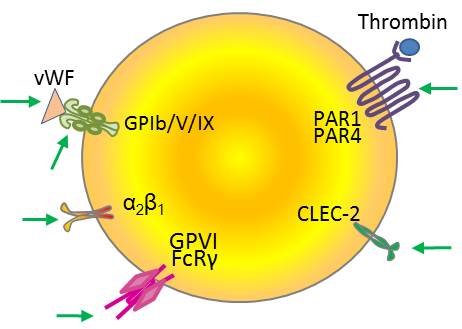See also UniProtKB-keyword

|
Figure 1: Different platelet receptors and one of their ligand. Receptors are the targets of venom proteins that activate platelet aggregation (see text for more details). |
Platelet aggregation activating toxins act by binding to platelet receptors as well as to their ligands. Until now, one ligand and five platelet receptors have been described to be activated by venom proteins:
- von Willebrand Factor (vWF) is a large glycoprotein that is released from endothelial cells in blood plasma as well as from platelets. Under high shear stress conditions, it promotes adhesion of platelets to the sites of vascular injury by forming a molecular bridge between sub-endothelial collagen matrix and platelet-surface receptor complex GPIb-V-IX. It also acts as a chaperone for coagulation factor VIII (F8), delivering it to the site of injury, stabilizing its heterodimeric structure and protecting it from premature clearance from plasma (Swieringa et al., 2014).
- GPIb (GP1BA) is a component of the GPIb-V-IX complex. This complex binds vWF (A1 domain), allowing platelet adhesion and platelet plug formation at sites of vascular injury. GPIb is composed of two disulfide-linked GPIbβ subunits that are non covalently linked to one GPIbα subunit.
- Integrin α2/β1 (ITGA2/ITGB1) is a receptor for collagen, and its function depends on conformational changes. Its activation depends on cytoskeleton-mediated kindlin-3 and talin-1 interactions. It is responsible for adhesion of platelets and other cells to collagens, modulation of collagen and collagenase gene expression (Nieswandt et al., 2009, Swieringa et al., 2014).
- Platelet glycoprotein VI (GPVI or GP6) is the principal signaling receptor for collagen on platelets. It is a member of the immunoglobulin superfamily, which associates with the ITAM-bearing FcRγ-chain. GPVI is only expressed on platelets and megakaryocytes. Stimulation via GPVI leads to full platelet activation, including integrin activation, secretion and procoagulant activity (Swieringa et al., 2014).
- Protease-activated receptors PAR1/F2R and PAR4/F2RL3 are G-protein coupled receptors that are activated by a subset of serine proteases, most notably thrombin. PAR1 is activated by thrombin with ~30 fold greater sensitivity than PAR4 (Sidhu et al., 2014).
- CLEC-2 (CLEC1B) is a C-type lectin-like receptor for which the physiological ligand is still unclear. However, two ligands have been described, the snake venom toxin rhodocytin and the mammalian glycoprotein podoplanin (Swieringa et al., 2014).
The table below shows the different platelet receptors and the ligand of one of them, as well as the families of venom proteins that target them.
| Platelet receptor activator | Families of venom proteins |
|---|---|
von Willebrand Factor (vWF)  (its interaction with GPIb is induced by the toxin) (its interaction with GPIb is induced by the toxin) |
Snaclec  disintegrin domain of metalloproteinases  |
| Platelet receptors | Families of venom proteins |
GPIb (GP1BA)  |
Snaclec  |
α2/β1 (ITGA2/ITGB1)  |
Snaclec  |
GPVI (GP6)  |
Snaclec  metalloproteinase  |
| Protease-activated receptors PAR1/F2R  and PAR4/F2RL3 and PAR4/F2RL3  |
serine protease  |
CLEC-2 (CLEC1B)  |
Snaclec  |
